Translate this page into:
Pinhole technique for cobblestoning in patients post mini-punch grafting for stable vitiligo
Corresponding author: Dr. Nandita Krishnagopal Patel Consultant Dermatologist, Kiran Hospital, Surat. drnanditapatel@gmail.com
-
Received: ,
Accepted: ,
How to cite this article: Bhingradia YM, Patel NK. Pinhole technique for cobblestoning in patients post mini-punch grafting for stable vitiligo. Indian J Dermatol Venereol Leprol 2021;87:861-3.
Sir,
Vitiligo is an acquired depigmenting skin disorder characterized by localized loss of skin pigment, secondary to multifactorial melanocyte damage. Most patients are adequately managed by medical means, except some who remain resistant to all non-surgical treatment modalities. The only effective treatment in this sub-set of patients is surgical replacement of damaged melanocytes. Punch grafting is an established treatment modality for stable vitiligo (more than one year) or in patients unresponsive to conventional therapies.1 However, relatively common complications such as cobble stoning, keloid formation, variegated appearance and peripheral halo have raised concerns among dermatologists regarding its acceptability. To overcome this complication, we attempted pinhole ablation using ultra pulse CO2 laser.
We report two patients with stable vitiligo who developed cobblestoning post mini-punch grafting using 1.5 mm punch [Figures 1a and 2a]. Both patients were willing to undergo corrective procedure for cobblestoning at 8-10 weeks follow-up. A signed informed consent was obtained from each patient. Cobblestoning was localized to lips in both patients. We administered topical anaesthesia on the affected sites, 40 minutes prior to procedure. The surgical field was cleansed using betadine and normal saline. The laser instrument used was CO2 laser 30 W machine with power 3 W operated in continuous mode. A small necrotic column was created in the center of each cobble stone by directing the laser beam to the top of lesion for 2–3 s, thus burning the excess skin at the grafted site in a vertical column fashion. The patient was advised to apply mupirocin ointment twice daily post procedure for two weeks. Healing of ablated skin led to shrinkage of elevated cobblestone areas, within 10-12 days. This allowed the settling of graft at base, thus improving the cosmetic appearance. The pre- and post-surgery and CO2 (day 1 and day 15) results are illustrated in Figures 1a-d and Figures 2a-c demonstrating significant improvement of cobblestoning.

- Patient 1 with lip vitiligo

- Patient 1 post mini-punch grafting on week 8
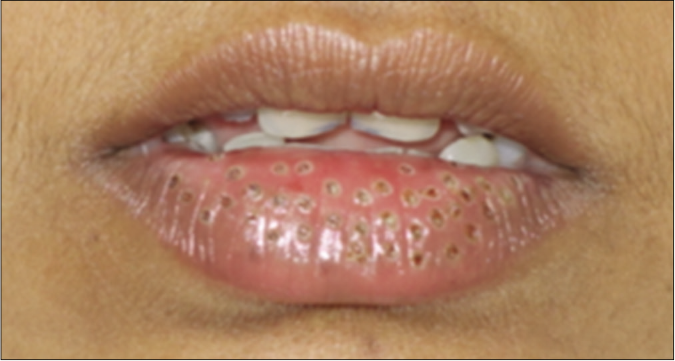
- Post pinhole ablation on day 1
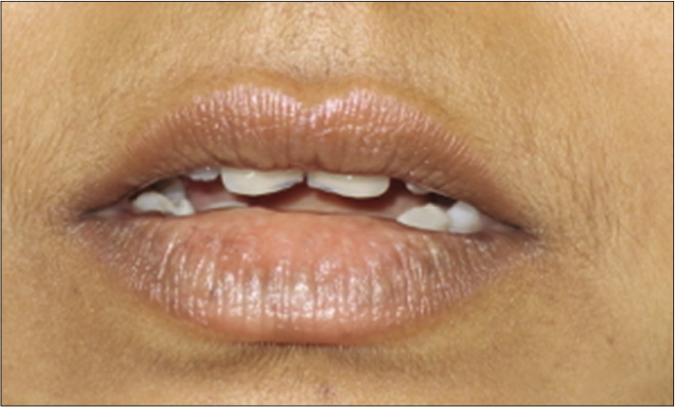
- Post pinhole ablation on day 15: patient 1
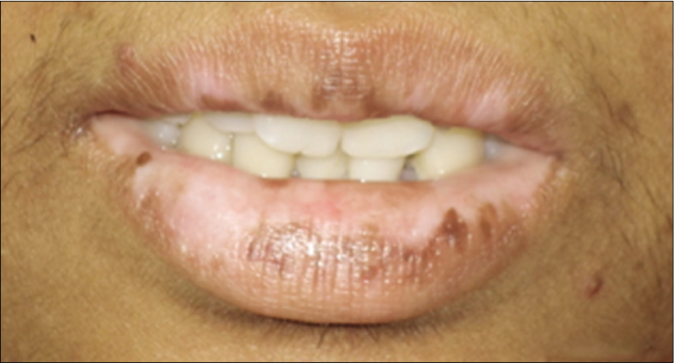
- Patient 2 with lip vitiligo
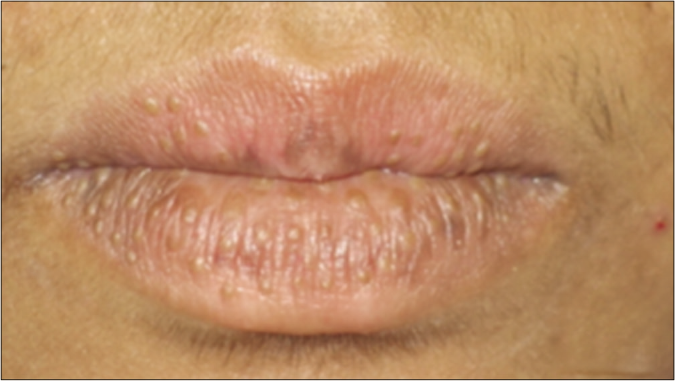
- Patient 2 post mini-punch grafting on week 8
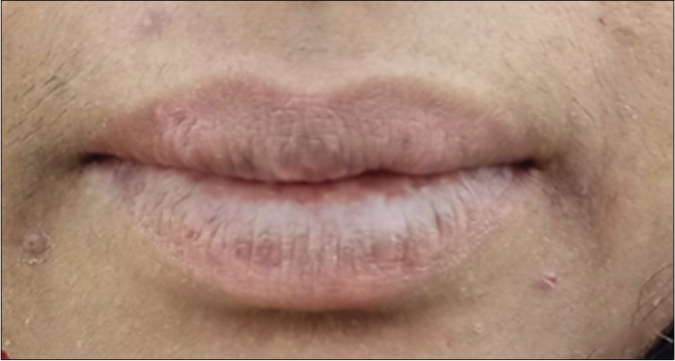
- Post pinhole ablation on day 15: patient 2
We are aware that split skin grafting and melanocyte transfer are more suitable for stable vitiligo compared to mini-punch grafting. However, we attempted this procedure to overcome the requirement of strict immobility and pressure dressing on the recipient area causing patient discomfort.
Cobblestoning is a morphological complication denoting raised skin surface, similar to cobblestones.2 It results due to excess amount of dermis in the donor graft which projects above the skin surface after grafting. Various modifications have been suggested over decades to prevent this complication. A study conducted by Falabella in 1988 recommended punch grafting using 1.2 mm punch, thus giving acceptable results, but subtle cobblestoning post-surgery could not be prevented.1 Additionally, the smaller graft usage resulted in 3-5 mm perigraft halos. Another study in 1995 by Boersna et al. suggested recipient holes about 1 mm deeper than the graft thickness to minimize lifting of grafts thereby reducing, cobblestoning. The limitation to this technique includes avoiding areas such as hands, fingers and wrists where superficial vessels, nerves, tendons, or bony structures may prevent proper preparation of recipient area.1,2 We chose CO2 laser over radiofrequency (RF) based on the principle of “Selective photothermolysis” by Anderson and Parrish which highlighted that high-energy powers and short pulse widths may be used to destroy intended target while inflicting minimal damage surrounding tissue to preserve grafted melanocytes.3 The edema and erythema post-RF may persist upto two weeks, thus having longer downtime than CO2 laser.4 Moreover, RF can result in undesired fat atrophy by heating the subcutaneous fat. This can be prevented using CO2 laser, where the amount of destruction and depth of penetration is time dependent.5 Ablative RF needling has been used for cobblestoning to facilitate coagulation but lack of precision during ablation prompted us to select, CO2 laser for this purpose.
In our technique, we created a column of necrosis each cobblestone using ablative CO2 laser, thus debunking the area to allow the graft to settle at the base for better cosmetic outcome. Furthermore, we used thin graft comprising only superficial portion of papillary dermis during our mini-punch grafting procedure. Both techniques combined may have attributed to our our excellent results. In author’s experience, the only may be an inability to create an adequately wide necrotic column, due to narrow beam of CO2 laser (0.3 mm). Hence, to overcome this limitation, we may need to extend the column using circular motion of hand piece. In the wake of our encouraging results, we recommend using ablative CO2 lasers to obtain better surgical outcome for cobblestoning.
Declaration of patient consent
The authors certify that they have obtained all appropriate patient consent.
Financial support and sponsorship
Nil.
Conflicts of interest
There are no conflicts of interest.
References
- Treatment of localised vitiligo by autologous minigrafting. Arch Dermatol. 1988;124:1649-55.
- [CrossRef] [PubMed] [Google Scholar]
- Autologous miniatures punch grafting in vitiligo. Indian J Dermatol Venereol Leprol. 1992;58:310-4.
- [Google Scholar]
- The role of the CO2 laser and fractional CO2 laser in dermatology. Laser Ther. 2014;23:49-60.
- [CrossRef] [PubMed] [Google Scholar]
- Comparison of microinsulated needle radiofrequency and carbon dioxide laser ablation for the treatment of syringoma. Dermatol Ther. 2019;32:12912.
- [CrossRef] [PubMed] [Google Scholar]
- Current laser resurfacing technologies: A review that delves beneath the surface. Semin Plast Surg. 2012;26:109-16.
- [CrossRef] [PubMed] [Google Scholar]





